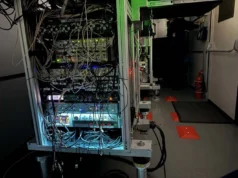Recent tests involving hand-launched deployments of sonobuoys from the CH-53E Super Stallion have demonstrated the aircraft’s adaptability, expanding its role within the U.S. Navy’s anti-submarine warfare (ASW) operations, according to a press release.
The tests, conducted by the Naval Air Systems Command (NAVAIR) at Naval Air Station Patuxent River, Maryland, showcase the versatility of the CH-53E.
Although primarily designed for heavy lifting, the helicopter’s success in deploying sonobuoys highlights its potential to take on additional, varied payloads.
The testing also sets the stage for similar operations with the next-generation CH-53K King Stallion as it prepares to replace the CH-53E in the fleet.
Colonel Kate Fleeger, Programme Manager of the Heavy Lift Helicopters Programme Office (PMA-261), mentioned the significance of the trials. “The H-53 is purpose-built to carry heavy loads, but that’s not the limit of our operational relevance,” Fleeger said.
“This test is just one example of the untapped capabilities of the H-53. Future payloads and the evolution of the H-53 in the battlespace are limited only by our imagination.”
They took place over the Atlantic Ocean near Virginia and were overseen by Adam Chesser, Lead Test Engineer for the H-53 programme. The focus was on ensuring that the sonobuoys could be deployed safely without endangering the aircraft.
“We evaluated the procedures and separation characteristics to ensure the sonobuoys would not strike the aircraft when launched,” Chesser explained. “Clearing the heavy lift aircraft for sonobuoy deployment creates another level of redundancy for the Navy and provides more resources and flexibility to complete the mission.”
The tests also presented an opportunity for cost savings and efficiency. Joe Pham, Assistant Programme Manager for Test and Evaluation at PMA-261, noted that the team’s choice of an alternative test range helped reduce expenses and adhere to the testing schedule.
“By exploring and using an alternative test range option to alleviate scheduling and funding constraints, we were able to execute the test on time and save cost to the programme,” Pham said.
PMA-261 oversees the full lifecycle of the H-53 family of helicopters, from procurement to disposal, while PMA-264 plays a key role in the development and maintenance of ASW systems. The success of these tests marks a significant step forward in broadening the operational uses of the CH-53E and its successors, enhancing the Navy’s ASW capabilities in the process.














Much smaller airframe but I wonder if sonobuoys could be hand deployed from Wildcats. Not much but given they can carry Stingrays it would the only means of anti-submarine defence for a Type 31 which has no sonars of its own and little likelihood of embarking HM2s.
T31s may deploy Proteus drones by the end of the decade (if we get a move on), which have already advertised a sonobuoy module.
I understand sonobuoys are fairly pricy. I once watched a tele prog featuring a T23 on patrol and it only had 32 sonobuoys for the helo. That seriously limited what it can do. In a real shooting situation you could run out quickly. So a cheap high volume sonobuoy would be real handy.
Apparently it’s 1k-10k depending. Seems fairly cheap, especially on the lower end. But in actual war I’d imagine they’d be getting flung all over the place
Yes that is the big problem. It will be millions of sonobuoys
I like the hand deployed part. Bit like chucking hand grenades out of your SE5 on to the enemy trenches?
Looking at the image. It shows the crewman lobbing the sonarbuoy between the narrow gap between the side of the ramp and the airframe.
Though not a CH53, in Afghan the Chinooks would drop off ammo bags etc via either the starboard front gunners door or more usually off the rear of the ramp.
Just wondering why they didn’t just lob it off the back of the ramp? Rather than trying to feed it through that narrowish gap. Seems a bit daft!